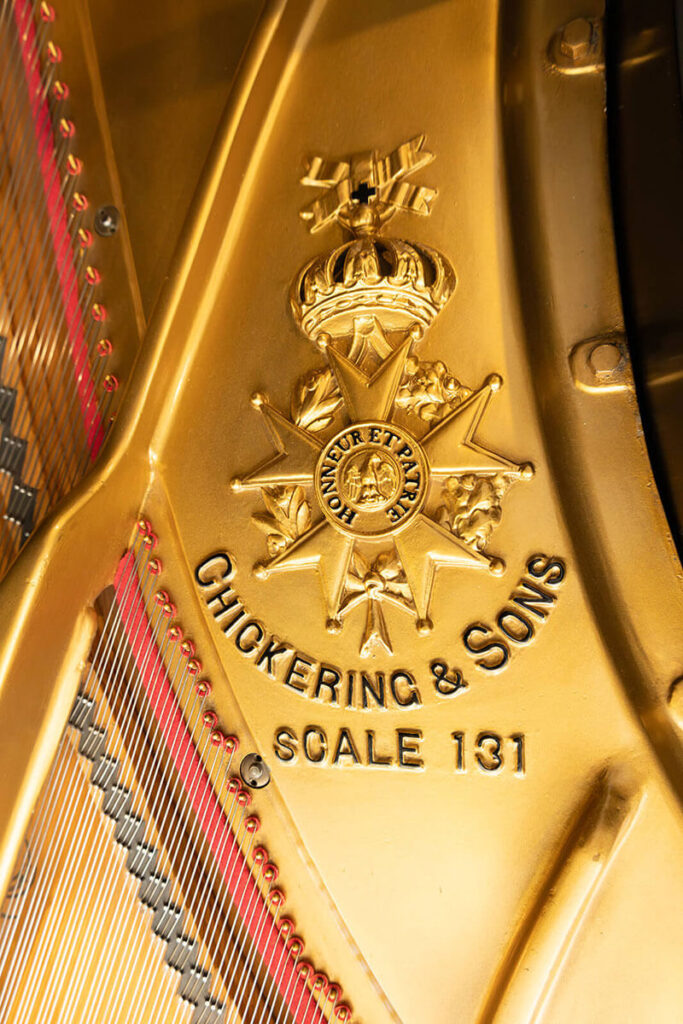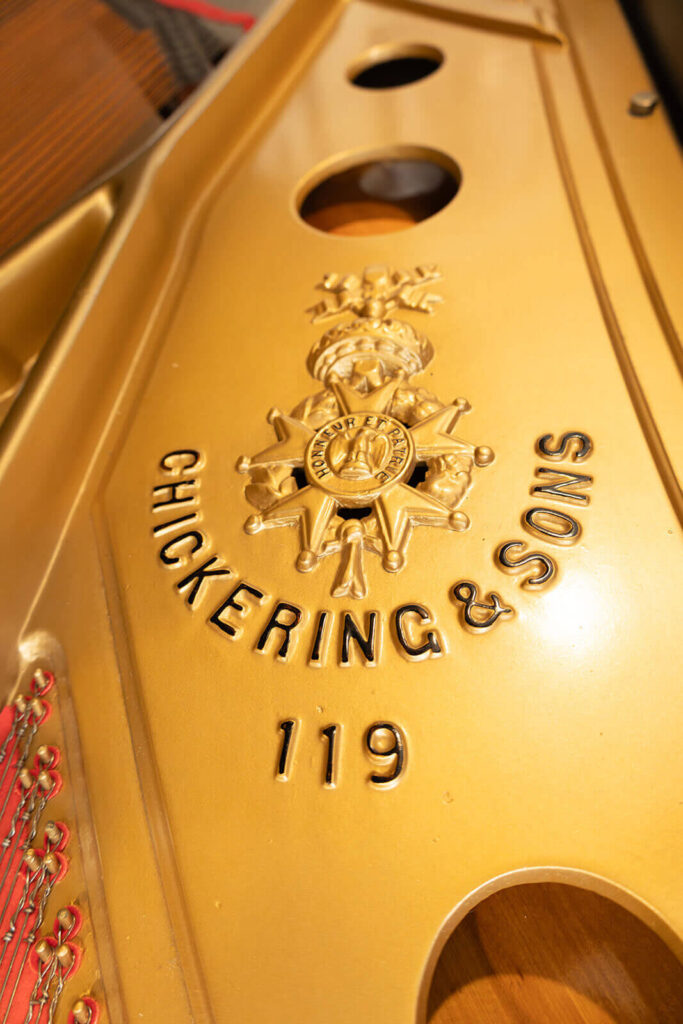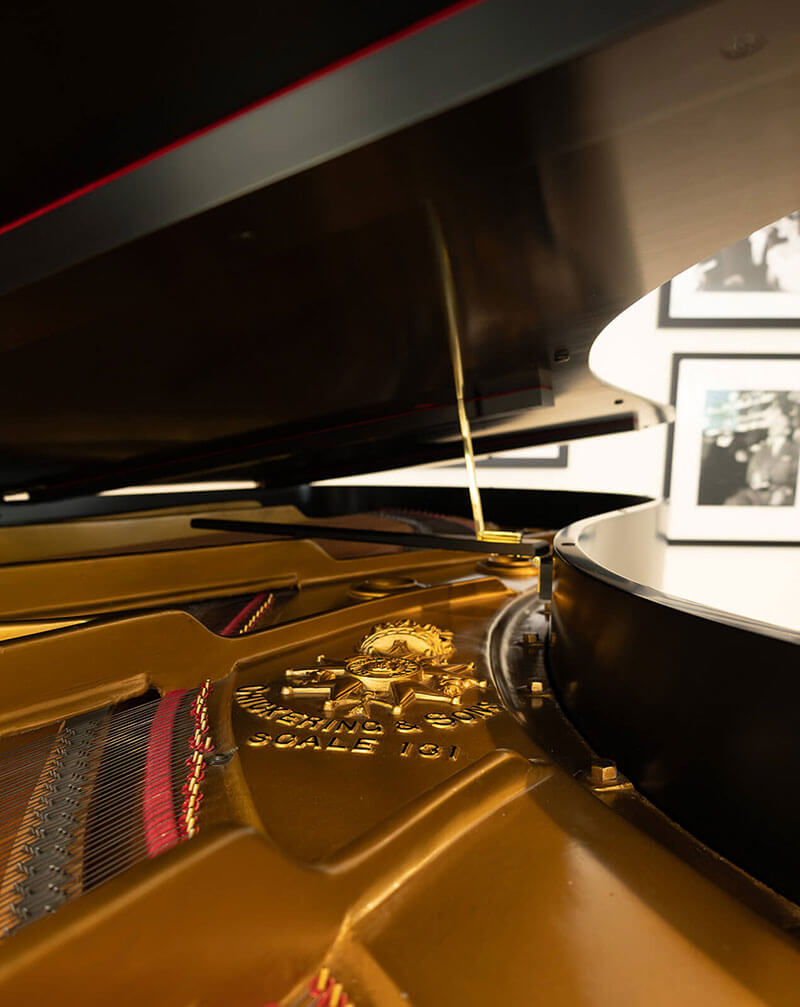Specifications
Chickering produced pianos for more than 150 years, and during that time, the company sold almost a quarter of a million pianos of different types, models and styles. This page is designed to help you deepen your knowledge of Chickering pianos for future sale, purchase or providence.
Jump to:
Piano Types and Subtypes | Year of Manufacturer & Serial Number | Model or Scale Numbers | Cabinetry Styles | Chickering Plates | Chickering Action Parts
Piano Types and Subtypes
In 1823, Chickering only made “Square” pianos, with strings running from left to right. By the late 1840s, Chickering had broadened its offerings to include Upright pianos with strings running from top to bottom, and Grand pianos with strings running from front to back. Here is a breakdown of all the Chickering piano types and subtypes throughout the years:
Year of Manufacturer and Serial Numbers:
Chickering assigned a serial number to their pianos before they left the factory. Therefore, the serial number reveals a piano’s age. The first Chickering piano made in 1823 would have had the serial number 1; the last Chickering piano made by Baldwin in the 1990s would have had a serial number of around 250000. Here are the serial numbers and corresponding manufacturing dates:
| Year | Serial Number |
| 1824 | 100 |
| 1825 | 316 |
| 1830 | 716 |
| 1835 | 1980 |
| 1840 | 4235 |
| 1845 | 6490 |
| 1850 | 10000 |
| 1855 | 15400 |
| 1860 | 22000 |
| 1865 | 27000 |
| 1870 | 35500 |
| 1875 | 46000 |
| 1880 | 55500 |
| 1885 | 70000 |
| 1890 | 78500 |
| 1895 | 85000 |
| Year | Serial Number |
| 1900 | 93000 |
| 1905 | 105000 |
| 1910 | 115000 |
| 1920 | 132500 |
| 1925 | 139700 |
| 1930 | 148400 |
| 1935 | 155200 |
| 1940 | 167200 |
| 1950 | 195000 |
| 1955 | 204000 |
| 1960 | 212750 |
| 1965 | 221117 |
| 1970 | 230300 |
| 1975 | 237578 |
| 1980 | 245989 |
From the 1920s until the 1940s, Chickering started to use a separate set of serial numbers for their large grands, which include both the Scale 131 and Scale 141 pianos. Those concert grand serial numbers range from 14000 to 16000.
Where to Look for a Serial Number:
In the 1860s, serial numbers were stamped onto soundboards, but by the late 19th Century, serial numbers were being stamped onto the iron plates. Often, the serial numbers appeared in black ink on the front part of the plate near the tuning pins. Sometimes the numbers were stamped on the side of one of the struts.
You should be able to find the serial number by visually scanning the plate. If your piano has been refinished in the past, you may see that the serial number has been painted over. A piano technician might be able to uncover the original serial number by gently rubbing areas where a serial number would usually go with a cotton ball and some paint thinner. However, it is easier to look for the serial number elsewhere. Technicians often wrote the serial number down in pencil on the inside of the case where the action tray sits. In some cases, the serial number was written on the action tray itself. You can also check the top of the legs and lyre but be careful not to confuse a serial number having five or six digits with a case number, which only has 4 digits. Unless you have an exceptionally old piano dating from before the Civil War, a 4-digit number you might see on a piano part is not a serial number.
Model or Scale Numbers:
Chickering called their piano models “Scales” and a piano’s scale number refers to the piano’s engineering design, which is a function of its iron plate configuration, string length and string thickness. Scale numbers were assigned sequentially. For example, the Scale 132 Upright Piano was designed right after the Scale 131 Grand Piano. Chickering was so proud of its engineering designs that it started to cast the Scale numbers into the iron plates. In many cases, you only need to look at the piano’s plate for the Scale number to figure out what model it is.
In addition to creating novel designs, Chickering made minor modifications to existing designs and these modifications were denoted by adding a trailing letter to the Scale number. Thus, Scale 110B signified a slight modification to Scale 110, not an entirely new design.
On older models from the 1870s and 1880s, the Scale number might appear in raised letters under the bass strings. By the 1890s, however, the Scale number appeared prominently on the right-hand side of the plate under a Chickering medal of honor. The Anderson Plate Scale 121 and Scale 123 pianos show the Scale number on the front part of the plate just below the treble tuning pins. Scale 122 pianos show the Scale number along the bass strut. It is often easier to find these Scale numbers with the music desk taken off.
Not all scales were used for production runs. Some scales were never built and others were only used to make a handful of prototype pianos. The following is a list of Chickering scales used for larger production runs from the 1860s to 1908:
Chickering Square Piano Scales

| Scale 17 | ??-1865 |
| Scale 23 | 1863-1864 |
| Scale 23 | 1868-1868 |
| Scale 36 | 1865-1866 |
| Scale 48 | ??-1866 |
| Scale 49 | ??-1866 |
| Scale 50 | 1866-1891 |
| Scale 50B | Unknown |
| Scale 51 | 1866-1867 |
| Scale 51B | 1867-1887 |
| Scale 51C | 1873-1892 |
| Scale 51D | 1885-1891 |
Chickering Upright Piano Scales
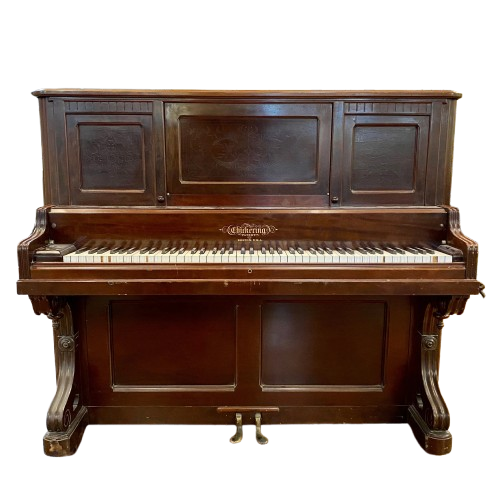
| Scale 57 | 1871-1872 |
| Scale 58 | 1871-1872 |
| Scale 60 | 1870-1876 |
| Scale 60B | 1874-1875 |
| Scale 60C | 1874-1876 |
| Scale 60D | 1874-1877 |
| Scale 62 | 1871-1872 |
| Scale 63 | 1871-1875 |
| Scale 64 | 1871-1881 |
| Scale 67 | 1874-1887 |
| Scale 67B | 1885-1895 |
| Scale 67BB | 1891-1900+ |
| Scale 67C | 1888-1888 |
| Scale 67D | 1891-1891 |
| Scale 68 | 1872-1877 |
| Scale 70 | 1875-1893 |
| Scale 70B | 1892-1897 |
| Scale 70C | 1888-1890 |
| Scale 79 | 1877-1890 |
| Scale 79B | 1887-1892 |
| Scale 85 | 1879-1879 |
| Scale 100 | 1886 |
| Scale 101 | 1884-1886 |
| Scale 103 | 1885-1885 |
| Scale 112 | 1891-1900+ |
Chickering Early Grand Piano Scales

| Scale 19 | 1867-1878 | Semi-Concert Grand |
| Scale 19B | 1874-1878 | Semi-Concert Grand |
| Scale 33 | 1862-1872 | Concert Grand |
| Scale 33B | 1866-1876 | Concert Grand |
| Scale 33BD | 1874-1875 | Concert Grand |
| Scale 33D | 1873-1878 | Concert Grand |
| Scale 33E | 1874-1884 | Concert Grand |
| Scale 33F | 1874-1876 | Concert Grand |
| Scale 46 | 1867-1875 | Parlor Grand |
| Scale 46B | 1874-1881 | Parlor Grand |
| Scale 73 | 1875-1876 | Concert Grand |
| Scale 74 | 1876-1877 | Concert Grand |
| Scale 76 | 1875-1883 | Concert Grand |
| Scale 77 | 1876-1890 | Concert Grand |
| Scale 80 | 1877-1879 | Concert Grand |
| Scale 83 | 1877-1879 | Parlor Grand |
| Scale 84 | 1878-1879 | Semi-Concert Grand |
| Scale 86 | 1878-1880 | Concert Grand |
| Scale 87 | 1879-1882 | Parlor Grand |
| Scale 89 | 1880-1882 | Concert Grand |
| Scale 90 | 1881-1883 | Parlor Grand |
| Scale 92 | 1881-1883 | Concert Grand |
| Scale 93 | 1881-1887 | Parlor Grand |
| Scale 94 | 1882-1886 | Semi-Concert Grand |
| Scale 95 | 1882-1886 | Concert Grand |
| Scale 97 | 1883-1886 | Concert Grand |
| Scale 97A | 1884-1889 | Concert Grand |
| Scale 97B | 1883-1887 | Concert Grand |
| Scale 98 | 1883-1891 | Semi-Concert Grand |
| Scale 105A | 1887-1888 | Concert Grand |
| Scale 105B | 1886-1896 | Concert Grand |
| Scale 106 | 1886-1890 | Parlor Grand |
| Scale 109 | 1888-1891 | Parlor Grand (6’3”) |
| Scale 110 | 1889-1891 | Semi-Concert Grand (7’7”) |
Chickering “Golden Age” Piano Scales

| Scale 109C | 1891-1900+ | Parlor Grand Yacht-Tail (6’3”) |
| Scale 105D | 1889-1900+ | Concert Grand Yacht-Tail (8’7”) |
| Scale 110B | 1890-1900+ | Semi-Concert Grand Yacht-Tail (7’7”) |
| Scale 116 | 1900-1910 | Parlor Grand Bent-Rim (6’4”) |
| Scale 119 | 1900-1910 | Semi-Concert Grand Bent-Rim (7’6”) |
| Scale 121 | 1901-1920 | Quarter Grand Anderson-Plate (5’6”) |
| Scale 122 | 1901-1920 | Petite Quarter Grand (5’0”) |
| Scale 123 | 1901-1920 | Parlor Grand (6’4”) |
| Scale 131 | 1910-1920 | Concert Grand Bent-Rim (8’9”) |
After Ampico took over the Chickering brand in 1908, the original Chickering Scales were gradually phased out and, in their place, Ampico introduced a new set of Scales. However, rather than advertising those Scale numbers in prominent places on the plate, Ampico cast them onto the back end of the plate where they would not be noticed as easily. If you have an Ampico-era model, open the lid and walk around to the back of the piano to look for the small numerals. They are usually near the bass string hitch-pins. Here is a listing of Chickering Scales under the Ampico ownership:
Chickering Ampico Grand Pianos

| Scale 133 | 1910-1920 | Quarter Grand (5’8”) |
| Scale 135 | 1920-1940 | Petite Quarter Grand (5’3½”) |
| Scale 138 | 1920-1940 | Semi-Concert Grand (7’9”) |
| Scale 141 | 1920-1940 | Concert Grand (8’9”) |
| Scale 144 | 1920-1940 | Quarter Grand (5’9”) |
| Scale 145 | 1920-1940 | Quarter Grand (5’8”) |
| Scale 146 | 1920-1940 | Parlor Grand (6’5”) |
Aeolian took control of all the Ampico brands in 1932 and stopped using Scale numbers. Instead, Aeolian began using Model numbers. Here is a listing of some of the models under Aeolian’s ownership. These numbers were not cast into the plate, so you have to determine the model by measuring the piano’s length from the start of the keys to the very back end of the piano:
Chickering Aeolian Grand Pianos
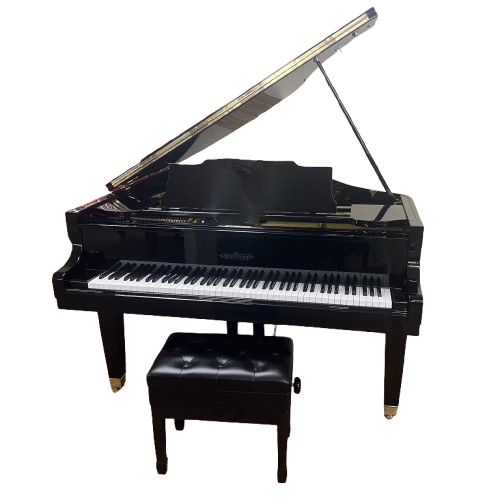
| Model 310 | 1932-1985 | Drawing Room Grand (5’9”) |
| Model 309 | 1932-1985 | Drawing Room Grand (5’8”) |
| Model 305 | 1932-1985 | Small Grand (5’4½”) |
| Model 301 | 1932-1985 | Baby Grand (5’1”) |
| Model 125 | 1950-1985 | Baby Grand (5’2″) |
Baldwin bought the Chickering name in 1988 and the models were changed once more. Baldwin seems to have made two different sets of Chickering pianos with two distinct groups of model numbers:
Chickering Baldwin Grand Pianos
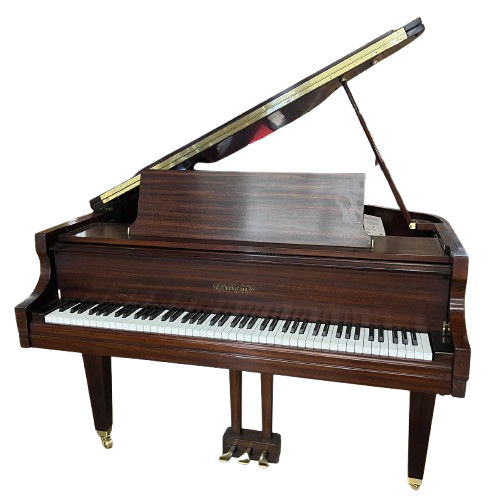
| Model 509CH | 1988-1995 | Drawing Room Grand (5’9”) |
| Model 507CH | 1988-1995 | Drawing Room Grand (5’7”) |
| Model 501CH | 1988-1995 | Baby Grand (5’1”) |
| Model 410CH | 1988-1995 | Petite Baby Grand (4’10”) |
| Model CH162 | 1988-1995 | Petite Quarter (5’4”) |
| Model CH176 | 1988-1995 | Quarter Grand (5’9”) |
| Model CH189 | 1988-1995 | Parlor Grand (6’2”) |
Cabinetry Styles
Chickering understood that the cosmetic appearance of their pianos was extremely important to buyers and the company went to great lengths to make their pianos attractive and stylish. The company was always willing to make custom designs for buyers who were willing to pay an extra fee, but most of the pianos sold were the standard design for their time. Those standard designs changed as tastes changed:
Chickering originally adopted the Empire style, which was used on both Square and Grand pianos for most of the 1840’s through the 1870’s. Note the straight legs:
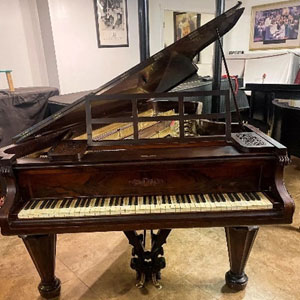
By the early-1880’s, styles became more ornate and Chickering adopted a rococo design, replacing the older Empire style:

In the late 1880’s, styles changed again, and while some of the more elaborate carvings remained, there was a return to straighter, ‘flowerpot’ legs. Chickering used the term “Style U” for pianos with this kind of cabinetry and it became the standard until about 1894.
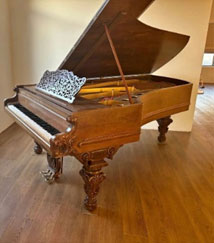
Around 1895, most of the Chickering grand pianos came with the company’s famous reeded ‘ice cream’ cone legs. Pianos of this era no longer had carved decoration on their sides but rather a simple decorative molding running along the sides of the piano and ending in a comma shape:
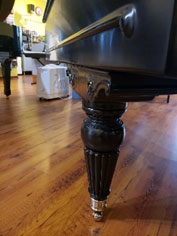
Around 1906 or 1907, Chickering replaced the reeded ‘ice cream’ cone leg with a fluted one and that design stuck around until the early 1910s.

Most pianos made by Chickering up to this point were finished to show off the wood veneer, but by the time Ampico owned Chickering, Steinway’s influence on piano design changed the look of Chickering pianos. The instruments of this era took on a black finish with straight legs.
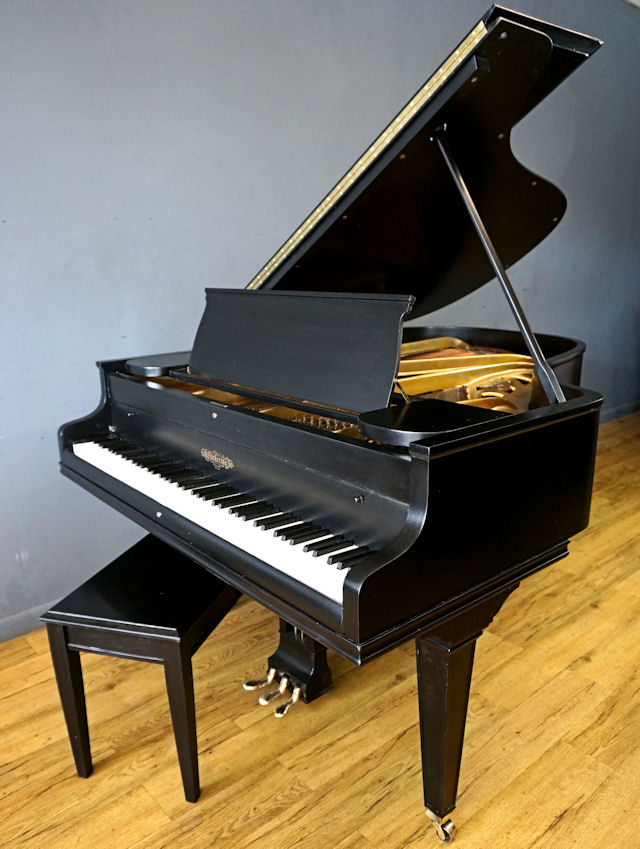
Chickering Plates:
As the Scales changed, so did the appearance of the Plates. Consequently, it is possible to identify the age of a piano by the look of the plate, which is very useful when the serial number is missing. For example, if you have a newer Chickering piano from the late 1980’s to the 1990’s, the plate will resemble other pianos made and sold by the Baldwin Company.

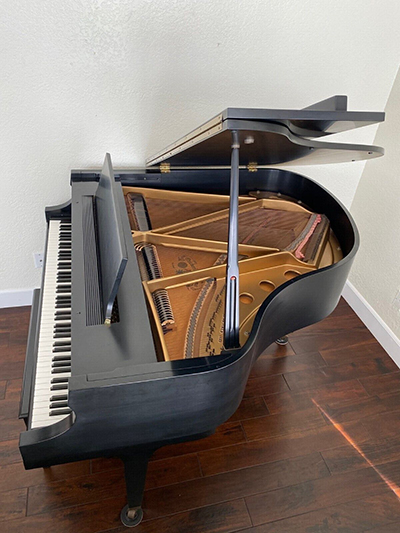
Chickering Pianos made during the Aeolian period had holes that were geometrically shaped with a triangle shape just above the round Chickering seal.
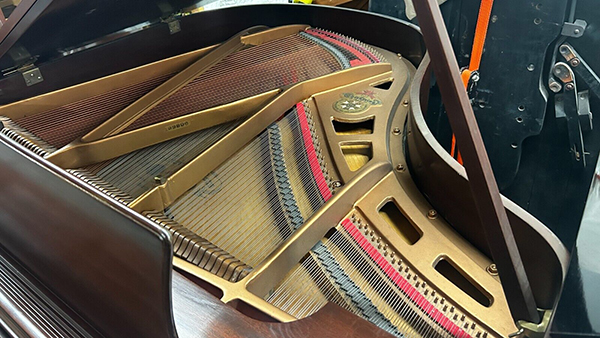
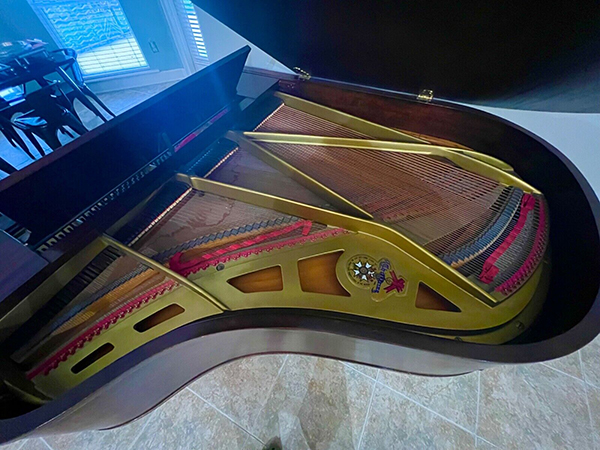
Ampico used several plates throughout the years. In the later years, the piano had geometric plate holes like the ones used by Aeolian. However, while Aeolian had a single triangular hole above the Chickering seal, Ampico had a couple of styles of plates with several holes above the seal.
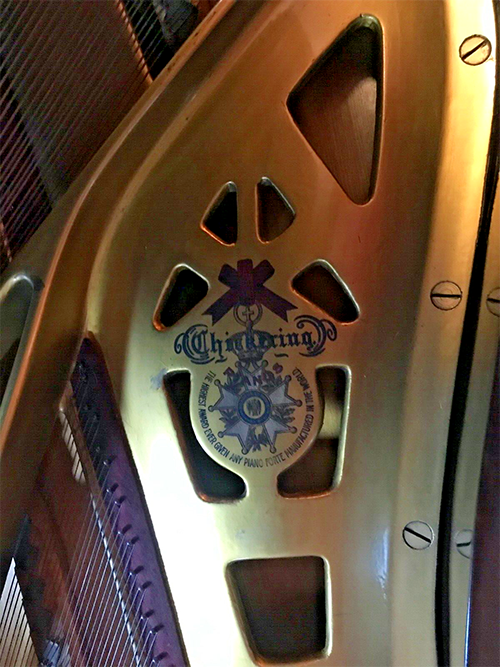
During the Golden Age, Chickering had two plate styles. The ones used on the Yacht-Tail and Continuous Bent-Rim pianos featured a large medal of honor:
The Anderson plates had a scoop on the right side, allowing more of the sound board to be exposed.

Chickering Action Parts
A piano has over 10,000 moving parts. When you press down on a key, the front of the key stick moves downward, the back of the key stick moves upward, a damper lifts off the string, a hammer comes up and strikes the string, and everything resets immediately so that you can press down on the note again. All of this is called the action.
Modern piano parts are standardized. However, this kind of standardization was not as prevalent in the 19th century. Originally, Chickering pianos adopted an English style action called Edwin Brown action, or Brown action for short. Brown action was considered an excellent design because it afforded the piano a light touch and quick response. However, as time went by, most piano makers settled on Swiss action rather than English action and in the 1890s, Chickering finally stopped producing Brown action entirely. Today, there are no modern Brown action replacement parts, so a repair technician would have to fabricate his own parts or salvage parts from another piano.
The alternative to English style action was the Erard action, also called Swiss action. Sebastian Erard invented the double escapement action in 1821. Chickering pianos made after 1890 use Erard action, but Chickering had its own versions and they are different from other manufacturer’s versions, so the parts are not interchangeable. In addition, Chickering’s different versions of Erard action are not necessarily interchangeable with each other. The action on a Scale 109C is different from the action on a Scale 123. To make matters more complicated, Chickering changed action design over time, so the Erard action on a Scale 121 made in 1901 might be different from the Erard action on a Scale 121 made in 1906.
When Ampico bought the Chickering and Sons Company in 1908, they began a process of standardization, so many of the issues related to these different versions gradually resolved. However, repairing and restoring action on older Chickering pianos can be challenging.
